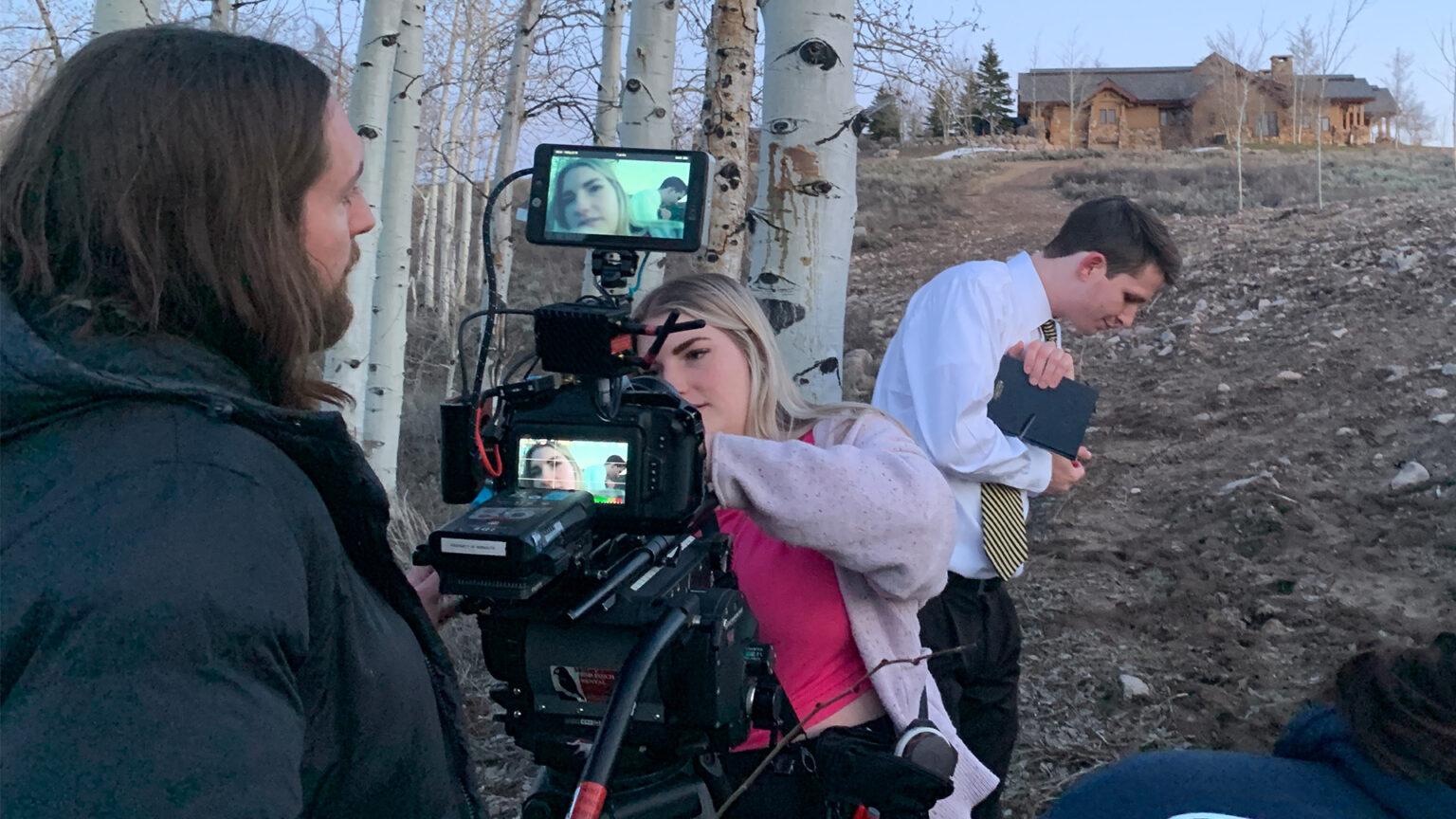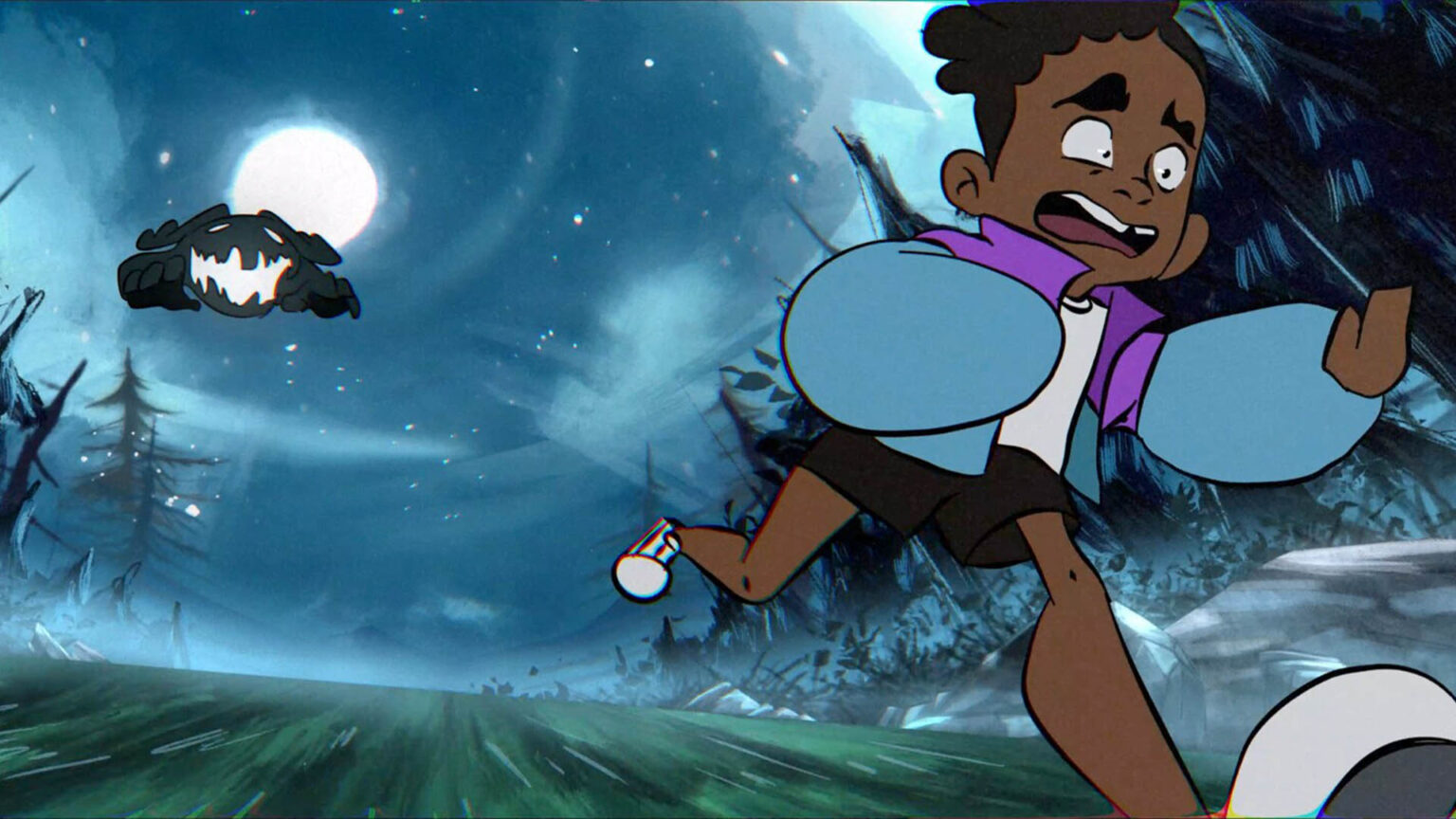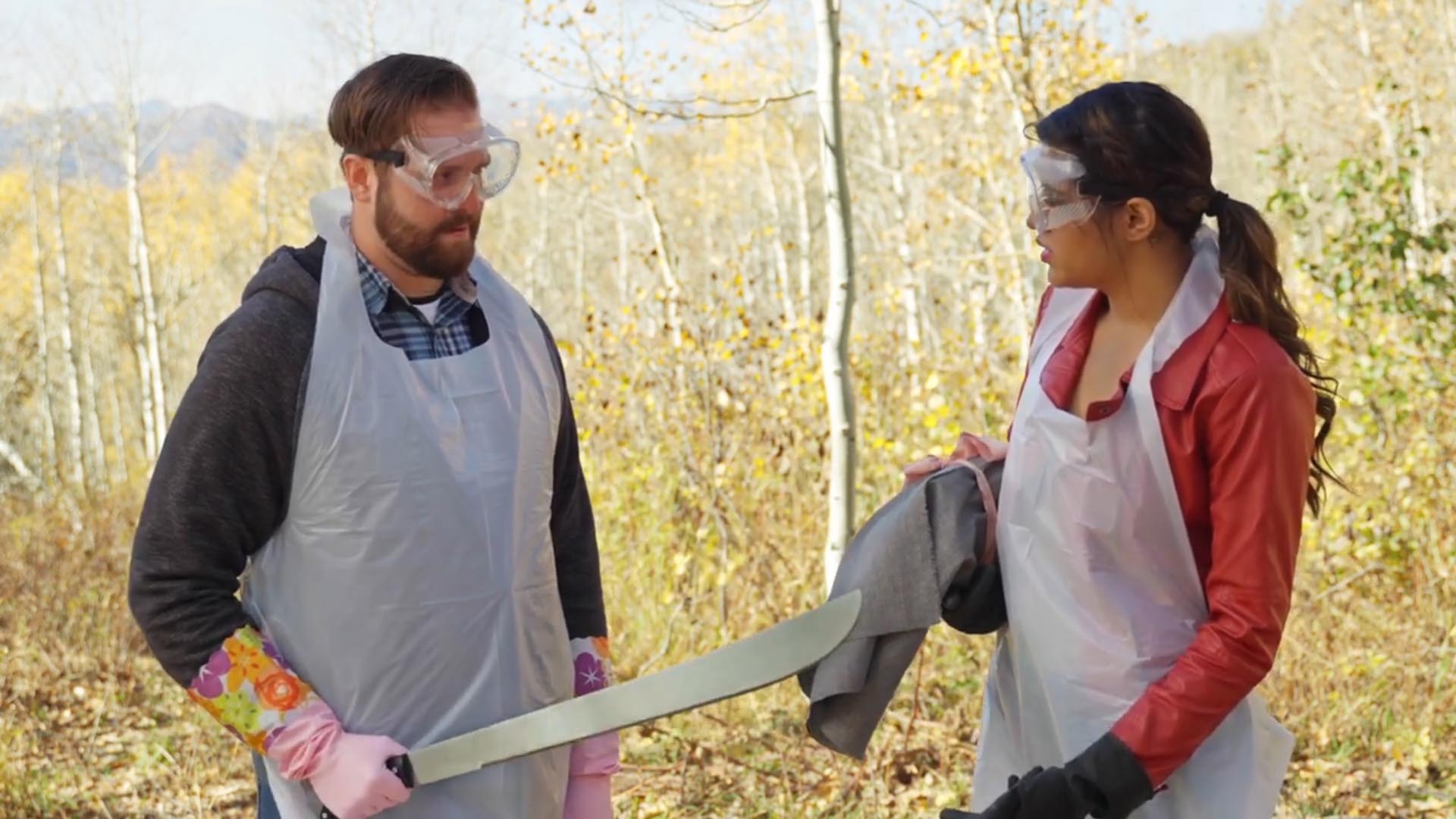Horror
The Handbook

If you or someone you know was a missionary that knocked on strangers doors, you know the fear is real. My palms would sweat and my anxiety would go through the roof when I was a missionary in California, so this film resonated with me really well. I had a candid conversation with filmmaker Brandon Carraway, the creator of the horror-thriller “The Handbook,” about the origins of the short film.
“The Handbook” draws its inspiration from Carraway’s missionary days with The Church of Jesus Christ of Latter-day Saints. The narrative stemmed from Carraway’s own adherence to the missionary handbook, emphasizing his inclination towards exact obedience. This obsession with following rules, a trait that Carraway candidly admits, became the driving force behind the film’s eerie plot.
“I would often bug my companions because of my pharisaical, letter-of-the-law observance of seemingly minor rules. After coming home, I wanted to make a film that captured my obsession with following the rules, so the idea for The Handbookwas born” said Carraway.
Carraway, a graduate of BYU’s film school, shared how “The Handbook” profoundly influenced his current filmmaking style. The project, crafted with friends from his time at BYU, left an indelible mark. Carraway expressed a desire to replicate the laid-back yet passionate atmosphere of the film’s production on future sets.

“I feel like every time I write a story now or pull together a crew, I try to replicate the atmosphere and experience that was had on set for The Handbook. Beyond that, my wife (one of the producers) and I have been lucky enough to screen at a lot of festivals around the states and every time we get to attend and watch the film with a live audience, we learn from their reactions what’s working, what we should try and improve for the next project and things we’d like to never do again.”

The conversation delved into the significance of the mountain cabin, a haunting backdrop that amplified the film’s fear factor. Carraway revealed that the cabin was secured before the story itself, a unique approach in preproduction. The location was offered by Carraway’s wife’s friend, whose family was selling the cabin.
“I wrestled with finding a good story for a while – I kept coming up with ideas of people wandering into cabins in the mountains that made no sense, I would always scratch my head and ask, “Why would the protagonist go inside this house?” Then it hit me: “Who goes inside creepy houses all the time?” Missionaries.”

Sharing his favorite moments, Carraway highlighted working with the actors, particularly Josh Fish and Caleb Hafen, who brought their missionary experiences to life on screen. The camaraderie with the crew added to the overall enjoyment of the filmmaking process. However, not without challenges, Carraway pinpointed the climax fight scene as the most difficult part of the production. Actor Barta Heiner’s patience and the collaborative efforts of the team ultimately brought the scene to life, though Carraway humorously vowed to hire a stunt coordinator for future fight scenes.

‘The Handbook’ stars Caleb Hafen as Elder Hafen, Josh Fish as Elder Weber, Barta Heiner as Gresilda Falls and Jason Wixom as Tulip Falls. Brandon Carraway served as Director/Editor/Writer, Hannah Grace Carraway as Writer/Producer, Trevor Free as the Director of Photography, and the score was written by Kaden Hendron.
For those curious about Carraway’s upcoming projects, he extended an invitation to follow his Instagram, @Trickedout7, and explore his YouTube channel, Waterslide Media. Residing and working in Provo, Utah, Carraway expressed eagerness to collaborate with fellow creatives. Additionally, the spotlight was shared with cinematographer Trevor Free, whose production company, Black Rabbit Monolith, promises a global visual spectacle. The audience was encouraged to reach out and explore Free’s work on his website: www.blackrabbitmonolith.com.
Now as I wrap up my conversation with Brandon I look back on how important it is for filmmakers to draw unique narratives from their personal experiences. I love telling the stories of filmmakers and look forward to whatever comes up next. See you on set.
Comedy
Meat Cute
Horror
An Arrangement of Skin

Several years ago I taught at Salt Lake Community College in the film department as an adjunct staff member. My favorite part of the position allowed me to give students the support they needed to tell their stories through cinema. I am impressed with the professionalism and skill that comes from young filmmakers starting their storytelling journey.
In a chilling exploration of family ties and the macabre, Cayden Turnbow’s short film, ‘An Arrangement of Skin,’ takes viewers on a haunting journey into the world of taxidermy and fractured relationships. The 14-minute horror/drama, shot entirely in Utah, weaves a tale of desperation, fear, and the unexpected bonds that tie us together.
The film centers around Abraham, portrayed by Dave Martinez, as he attempts to reconnect with his taxidermy-obsessed brother, Malachi, played by David Van Freankenhuijsen, in the aftermath of their mother’s passing. Marianne Bess delivers a captivating performance as Mother, adding depth to the family dynamics.
In my exclusive interview, Cayden Turnbow delves into the origins of the film’s eerie concept. Turnbow recounts that inspiration struck after watching ‘Midsommar,’ leading Turnbow to explore the idea of a taxidermied human. However, it was the fear of losing the chance to mend his relationship with his own brother, who was serving in Iraq at the time, that infused the storyline with a personal touch.
“I didn’t have the best relationship with my brother at the time,” said Turnbow “and when I found out he was leaving I was scared that I would never get the chance to rekindle that relationship. We’re closer now but that fear is very much what inspired aspects of the plot in An Arrangement of Skin.”
As a student at the University of Utah, Turnbow made strategic use of available resources. Enlisting the help of talented alumni, including DP Jack Houghton and Sound Mixer Jasmin Xanthos, Turnbow managed to bring his vision to life. The Film Production Club, along with mentors Sonia and Miriam Albert-Sobrino, played crucial roles in supporting the ambitious project.

“I utilized literally every resource that was available to me for this film and beyond. The gear and students were one thing but I also had the pleasure of bringing on a number of alumni to the set,” said Turnbow. “I was able to receive a number of grants through the Undergraduate College that helped immensely. Funny enough I found another less traditional route that helped fund my film as well. That year I was able to receive a scholarship that paid for my housing on campus and I made the decision to leave that housing for my final semester because I could receive a refund for the remaining amount that would have otherwise been applied to my dorm, I put it all back into the movie.”
The casting process, Turnbow’s favorite part of directing, involved a wide search for talent.
“I chose to only film with three actors, and specifically only two with speaking roles so that I could push myself to focus on working with those actors specifically. I cast a wide net for auditions; talent agencies, Facebook groups, casting calls, and even actors I already knew. After initial video auditions, I had callbacks and eventually a chemistry test between 4 of my top picks. It’s funny though because even with all that preparation on the first day of set I received a call from one of my two actors, he had gotten Covid. So while the rest of my crew were setting up for the first shot my producer and AD were helping me track down the other actor that made it to that chemistry test. We eventually got ahold of him and he was there that day to take on the role of Malachi. The rest of the day I was running between giving direction on set and running back to rehearse with my actors. “

Despite facing unexpected challenges on set, the chemistry between the actors, David Van Frankenhuijsen and Dave Martinez, elevated the film to unforeseen heights. Turnbow also acknowledges the indispensable contributions of producer Bronwyn Laherty and Assistant Director Ali Akbari in navigating the casting hurdles.
Reflecting on the film’s production, Turnbow highlights the creation of a pivotal prop—a taxidermy version of a human head—as a challenging yet rewarding endeavor. The meticulous process involved collaborating with a talented artist, Emily Madsen, who brought the nightmarish vision to life.
“I didn’t know where to even start with this, but luckily I met someone in a web design class who created a portfolio site for a ton of cosplay costumes/props that she made from scratch. I talked to her after class about the possibility of creating a taxidermy human head and she was down to take a stab at it. We basically took one of those hairdresser plastic heads and built it out of plaster from there. We had to buy fake teeth, eyeballs, stitches etc. Then in post, I made some slight alterations in After Effects to make it work even better.”
However, not all challenges were artistic; acquiring taxidermy animals proved to be a daunting task. Turnbow shares the intricacies of securing the animals, from crawling through dusty attics to strategically mounting them on the set. The dedication of the art director, Ken Gondor, and Aura Martinez Sandoval, played a vital role in bringing the unsettling environment to the screen.

“Getting the taxidermy animals was a much larger ordeal than I could have ever imagined. One, finding people who had taxidermy animals that I could borrow was the first hurdle because renting them would be astronomically more expensive than I could afford. Luckily, I was able to use a combination of my uncle’s and my set designer’s late brother-in-law’s taxidermy collections to fill the space. It took multiple days of crawling through dusty attics and basements as well as strategizing a safe way to transport all of the animals to get them to set.”
” We also had to be extremely careful with how we mounted them on the walls, I was lucky enough to be using a friend’s house for this shoot so they let me put in a few nails in the walls but most of them had to be on command hooks. My art director even went the extra mile to weigh every animal that we hung on the wall and made extra sure to use more than what we needed for them to be secure.”
‘An Arrangement of Skin’ served as a transformative experience for Turnbow, igniting a passion for independent narrative filmmaking. While co-producing the upcoming film, “Post Credits,” Turnbow is already brewing ideas for his next project, promising something even more daring.
“I’ve been lucky to find myself within a talented cohort of filmmakers with a similar passion.”
For those eager to follow Cayden Turnbow’s filmmaking journey, he invites audiences to connect with him on Instagram (@caydenturnbow). Additionally, the film has its dedicated Instagram page (@aaos_film), providing a deeper insight into the eerie world of ‘An Arrangement of Skin.’
Comedy
Camp Kona

Camp Kona, a short-form animated monster movie, takes us on a nostalgic journey through 80’s summer camp adventures, combining elements of thrill, humor, and mystery. The film revolves around Jasper, a reluctant camper at Camp Kona, who stumbles upon the dark history of the camp and unravels the mystery behind the disappearance of a girl named Kaia during the summer of 1982.
Adriel Meka, the Writer/Director of Camp Kona, drew inspiration from his favorite 80s movies and Spielberg films, aiming to capture the essence of retro horror and iconic cult classics. Reflecting on his childhood experiences at summer camp in Canada, Meka envisioned a story that blends magical realism with imagination and sci-fi, echoing the spirit of movies like The Goonies and Stranger Things.
“This began to develop into the idea of a kid going missing at the camp and then our new protagonist exploring the aftermath of a place with a dark history” said Meka. “Jasper was inspired by my younger self and the story follows his experience in overcoming a reluctance to attend camp once he found something unexpected to make it fun. A thriller theme and humorous characters enabled me to explore a full range of emotions through the film and knew I also wanted it to have a fitting retro soundtrack. Once I had the story written all the pieces were in play, and I moved into the next stages of getting to direct and work with a wonderfully talented team that helped bring Camp Kona to life!”
Movie making is hard in both live action . Camp Kona marked Meka’s directorial debut in animated short films, requiring him to lead a crew, manage artists, and navigate the complexities of animation production. The film was initially conceived as a 3D dystopian sci-fi project, but Meka pivoted to align it with his love for retro films, resulting in a condensed production schedule.
While discussing his favorite part of production, Meka expressed his deep love for directing, emphasizing the joy of creating characters and stories that resonate with both him and the audience.
“Camp Kona’s protagonist, Jasper, is like a younger version of me and a piece of how I see the world. There’s something deeply fulfilling about coming up with these characters and tales that are close to you then, being able to get other people excited about it.”
The challenges pushed Meka to learn the intricacies of building a crew, developing an animation pipeline, and becoming a director. The experience, though initially daunting, became an exciting journey of growth and self-discovery.
“I learned the importance of a team and how even though “alone you can go fast”, “together you can go far” The process of making the film gave me the chance to grow as a leader, a creative, and as an individual. and I wouldn’t change it for the world”
Looking back, Meka contemplates the possibility of a different approach, expressing interest in showcasing his 3D skills in a reimagination of Camp Kona. Imagining the characters in a detailed 3D world, he draws inspiration from stylized CG animations like Arcane and Spider-Verse, envisioning a sequel that explores new visual territories.
For aspiring filmmakers, Meka offers advice rooted in authenticity and collaboration. He encourages creators to use the medium as a voice to express their inspirations genuinely and emphasizes the importance of building a great team. Meka highlights the continuous growth in any artistic endeavor, urging individuals to accumulate “pencil mileage” and persevere through the inevitable growing pains.
To stay updated on Meka’s projects and the journey of Camp Kona, audiences can follow the film’s Instagram account @CampKonafilm. For more insights into Adriel Meka’s work, his personal Instagram account @arekusan_meka , provides a glimpse into future creative endeavors.














